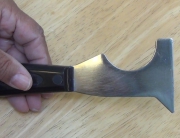How to do a Skim Coat. Have an unsightly plaster wall or ceiling in your home that you’ve always wanted to smooth out and re-paint? Perhaps the wall has been repaired too many times over the years, or maybe there is a textured finish that you just don’t like. Unlike with drywall, there are few options with plaster, but fortunately the easiest option can be accomplished by anyone, with the right tools and training on the technique, known as a skim coat. Watch this video to learn how to smooth out plaster to a perfectly smooth, glassy finish. We show you:
- All the tools that you will need to complete the job (you will need just a few plasterer’s tools for this job)
- How to select the right material (mud) to complete the skim coat
- The step-by-step technique for completing a skim coat, from how to use your hawk and trowel, to how to manipulate your mud, and how to use water as your “plasterer’s sandpaper” to produce a beautiful, smooth finish
With the right tools and a little bit of practice with the technique, you can easily complete this job yourself. You can do this!
Copyright 2014, See Jane Drill, All Rights Reserved







Thanks for your informative videos. It’s obvious you have natural talent enhanced by years of hard work honing your skills.
Thanks, Scott, I really appreciate the compliment!
What brand of mud do you use and place of purchase?
Great explanation thanks. My entire house has textured walls that i want to smooth out. They have been painted (several times) – is it necessary to prime the walls first to be sure the skim coat adheres?
I would also love an answer to this, I have the same issue. If primer is needed, it there any special kind of primer to use?
Hi Kristy, it’s likely that you will get “flashing” if you don’t use primer. As for the type of primer, there are so many products on the market and they change so often that I would advise you to ask at the paint counter what type of primer is best for preventing flashing. It will also depend on the type of joint compound you are using.
I have a cove ceiling. How do I deal with the corner where the two walls and ceiling meet?
Great DIY! gives me a bit more confidence than I had before.
G
I appreciated the clear descriptions on this video. One aspect that wasn’t clear to me is whether you wait after each step until the coating is dry to the touch but still damp. I assume that scraping off the loose pieces after the skim coat is done would require some drying as did the step after the first part of the finish coat. Do you have to wait minutes or hours in between the steps?
I was also pleased to discover your website. It looks very useful.
Hi Jean, sorry for the delayed response! You want to wait until the mud is firm to the touch, but still damp. As for how long it takes, it really depends upon the type of joint compound you are using, and the conditions, i.e. humidity, temperature, etc.